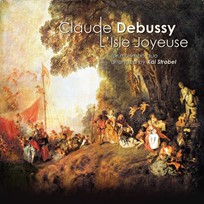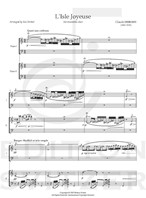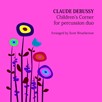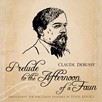
L´Isle Joyeuse
Composer: Claude Debussy / arr. Kai Strobel
Instrument: Marimba Duo
Level: Advanced
Published: 2020
Price: €25.00
Item details
-
Description +
-
Duration: 5 min.
Arranged by Kai Strobel
_______
In honor of the 100th year anniversary of Claude Debussy's death in 2018, I decided to arrange a selection of piano pieces for Marimba, Vibraphone, and other Idiophonic instruments. Transforming these musical works to modern percussion instruments awakened my curiosity. It provides a wellfitting framework for Debussy's fundamental compositional idea and his source of inspiration: traditional Asian percussion music.
Debussy developed an individual musical language inspired by a Gamelan Orchestra, which he was introduced to at the World Exhibition in Paris in 1889. Including exotic gamelan elements in the composition, multiple uses of pentatonic, hexatonic and heptatonic scales as well as structural elements like the imitation of low gongs illustrate the Asian influences.
The extended solo piano piece L'Isle Joyeuse, which Claude Debussy composed in 1904 encloses these ideas. As one of the most famous classical piano works by the French composer, the ecstatic nature of this piece is intriguing. Debussy's positive emotional state in the composition process accounts to that. The piece was primarily created on the English Islands, which he fled to accompanied by his mistress to escape the city's social corset. When I decided to arrange it, I choose two Marimba as they match the requirements of the original composition best. In this Duo Version, the changes between accompaniment and melody parts are very fluent. The players need to be very focused in order to match congruent sound colors and dynamics.
Kai Strobel
-
-
Instrumentation +
-
Two Marimbas (5-octave)
-
-
About the composer +
-
Claude-Achille Debussy (22 August 1862 – 25 March 1918) was a French composer. Along with Maurice Ravel, he was one of the most prominent figures associated with Impressionist music, though he himself disliked the term when applied to his compositions. He was made Chevalier of the Legion of Honour in his native France in 1903. Debussy was among the most influential composers of the late 19th and early 20th centuries, and his use of non-traditional scales and chromaticism influenced many composers who followed.
Debussy's music is noted for its sensory content and frequent usage of nontraditional tonalities. The prominent French literary style of his period was known as Symbolism, and this movement directly inspired Debussy both as a composer and as an active cultural participant.
-
-
Reviews +
-
Review (Percussive Notes, October 2021)Debussy’s “L’Isle Joyeuse” is a stand-alone piano solo composed in 1904, inspired by French painter Watteau and Debussy’s own journeys to a special island with a beloved. The piano work is best described in the composer’s own description that it combines every way of attacking the instrument, uniting grace and force. Kai Strobel shapes this solo into a duet for two marimbas, sharing the responsibility while creating a successful reimagining of the original.Strobel’s arrangement stays fairly true to Debussy’s composition, although several modifications make for a more entertaining, idiomatic duet. Strobel transposes the work from A to C to fit better on two low-C marimbas, and he frequently shifts the melody from player to player. This requires tremendously talented players for both parts and increases the visual appeal, as both marimbists jump from lower to higher octave and back. One of the greatest difficulties in the piece is found in these shifts, as both players must tailor their dynamics and perfectly blend with the previous entrance to match the original intent. Another set of challenges are the rapid runs throughout most of the piece. Quick arpeggiations that fluidly fit under a pianist’s fingers require a different approach on marimba. This could result in a slightly slower performance, losing some of the zeal and appeal of the original composition.Although most of Debussy’s works that are arranged for percussion focus on the slow-moving, traditional impressionism of the composer, “L’Isle Joyeuse” is unmistakably Debussy and transitions to marimbas well. Whole-tone scales along with Lydian and Ionian modes present themselves over rapid ostinatos through playful melodies juxtaposed against stabs in the bass. Due to the overwhelming speed and dual roles that each part requires, Strobel’s arrangement is well suited for two graduate students or professionals looking to impress an audience.—Matthew Geiger
-
-
Credits +
-
Front Cover graphics and layout: Ronni Kot Wenzell
Photo: Daniel Delang
Engraving: Kai Strobel & Johan Svitzer
Printed in Copenhagen, Denmark
Copyright © Edition SVITZER
www.editionsvitzer.com
-






